You are thinking about a houseboat vacation in Ireland, but you have never been cruiser-boating?Then you’ve come to the right place. In this article I will give you some important practical tips that will help you to mentally prepare for your houseboat or cruiser boat vacation.
Page Contents (click line to jump the text)
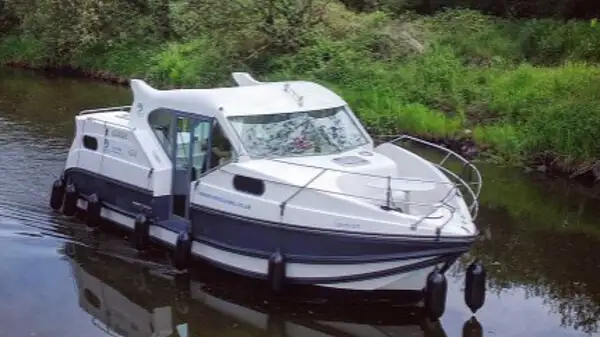
Intro
I sailed sailing boats a lot in my younger years and have two sailing licenses, for inland waters and for the coast. I also have the German sport boat licenses Binnen and Küste (for motor boats) and have vacationed on various boats – including houseboats of course.
I come from Germany, but I also know Ireland very well because my family and I have had our second home here for a good 10 years.
But let’s get back to your upcoming houseboat vacation:
Choosing the boat rental, the location and the right boat
Let’s get straight to the point: Since houseboats move very slowly, you don’t need a boating license or any previous experience to rent a houseboat in Ireland. A good boat rental company will give you a practical instruction and then you can go.
However, the choice of boat and boat rental is very important, especially for beginners.
You need a good, reputable boat rental company that can help you at any time, not only with questions about the boat, but also with questions about the travel organization, the choice of route and problems on the way.
You want a well-maintained boat in good condition so there are no surprises along the way and everyone is comfortably accommodated.
The boat should not be too big, otherwise you will be quickly overwhelmed as a beginner. But it shouldn’t be too small either, and it should fit well with the needs of your family or tour group.
In addition, you need a landlord who can give you a good briefing and is available in case of problems on the way.
I have already written an article about boat rentals in Ireland – just click here.
And for choosing the best boat you can find another article here.
My practical tip:
Look at the websites of the rental companies, make a pre-selection and write down some questions: Best boat for beginners, best area for beginners, how does the briefing work, how does the arrival and departure to the boat rental work, which is better, round trip or one-way trip, etc….
Then call at least two rental companies, tell them what you want to do and let them advise you. If your English is not perfect, it doesn’t matter, the boat rental companies are used to foreign tourists and the Irish are usually very friendly and helpful anyway.
It’s always good to have a personal contact and get a feel for how you’ll be taken care of there. Does everything feel good? Then you can choose and book.
The most important areas in Ireland and Northern Ireland are the lower River Shannon with its lakes, the upper River Shannon with its lakes, the Shannon-Erne- Waterway System and the River Erne with the Upper Lough Erne and the Lower Lough Erne.
If you have chosen your boat rental, you may have already chosen the area. But there are also rental companies that are present everywhere, then you still have the choice.
What do you prefer, big open lakes, or quiet rivers and canals? Do you want to moor more often, or not so often? Do you want to use locks more often, or not, are certain places or sights important to you? Let your landlord advise you which area and which routes he considers beginner-friendly.
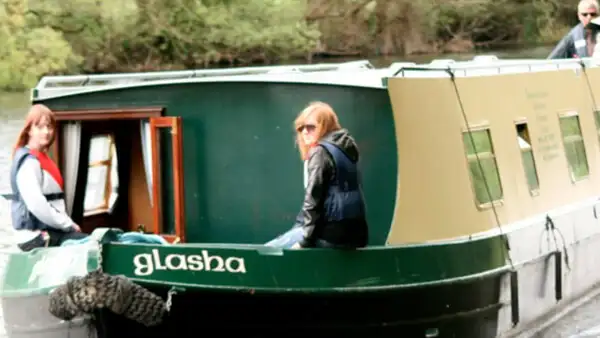
My practical tip:
It can get windy in Ireland, very windy in fact. Open lakes offer little protection from the wind and can build up decent waves on the lee side, which is the side away from the wind. Houseboats are generally very slow moving – so you get a long time out of it :-).
I think that smaller canals and smaller lakes are more manageable and less difficult at the beginning, even if you have to lock from time to time. You get used to locks quickly and it’s even fun!
Now let’s get to driving the houseboat – an introduction:
Safety First – Safety tips
A few practical safety tips: Even if it seems excessive to you, every person on board should always wear a life jacket. How easy it is for someone to go forward, slip and fall into the water. Especially for children, a life jacket is absolutely mandatory.
When docking, casting off and locking, it’s easy to get a hand or foot between the side of the boat and the dock – this can lead to dangerous injuries – so always make sure to keep your arms and legs inside the boat.
The boat has a propeller at the stern (aft). This can be very dangerous for swimmers – if there are swimmers in the water – turn off the engine!
Houseboats move slowly, but have a large mass, which means they accelerate slowly, brake slowly, and turn slowly. So always watch for encounters with other boats or obstacles in the water to be able to react early.
Traffic rules on the water
On the road there are traffic signs and right-of-way rules, and on waterways there are too.
In general, right-before-left applies, motorboats give way to sailboats and all pleasure boats give way to commercial vessels.
When two motorboats meet head-on, each gives way to the right.
In the lock and harbor area, sailing is very slow and outgoing boats have priority over incoming boats.
Your boat rental company will brief you on the local rules and will also have a leaflet for you on board. You can read this once on the first day and then leave it at the helm for reference.
Lights, navigation signs and signals on the water
Motor boats have lights for better visibility. The right side is green, the left side is red and there is a white light at the stern. This allows other boats to see you even in poor light or at dusk and know right away which side they are looking at and where you are going.
Of course, you can see other boats just as well.
Furthermore, there are navigation signs, mostly signs or boards, as well as lights and traffic lights, for example at the locks.
These regulate the traffic on the water. Your landlord will instruct you and have a leaflet for you on board with which you should familiarize yourself thoroughly.
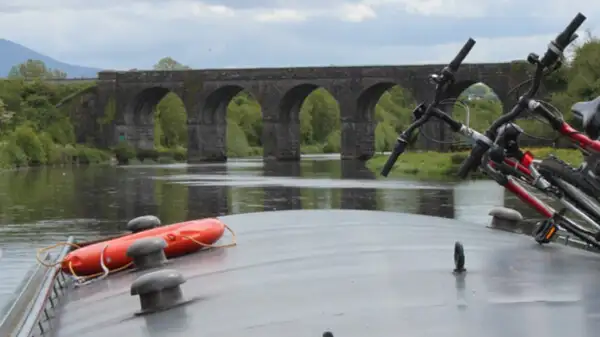
Maps, compass and harbour handbook
Orientation on the water is usually very simple. You will have a water map and a harbour handbook with you in which all important piers, harbours, gas stations, locks and so on are listed.
Water depths are also indicated. Your landlord can tell you the draft of your boat and it will also be indicated on the boat. Shoals, i.e. shallow areas, must be avoided, but they are usually marked by navigation marks.
Shallow shores, such as reeds, are not marked. Here, too, you should keep a respectful distance so as not to run aground on the one hand, and not to damage or disturb the fauna and flora on the other.
Lines, knots and fenders
Your boat needs several lines for mooring. Usually there are one or two lines at the bow (front) and one or two lines at the stern (back). Sometimes boats moor alongside other boats, for example in the waiting area of locks or in some harbors. You need lines for that as well.
In addition, the fenders have lines with which they are attached to the boat.
In locks you need lines to keep the boat in the same place when the water is flowing in or out and the water level is rising or falling. The line is attached to the boat, passed through a ring or bollard on shore and then held by a person on the boat and shortened or lengthened as needed.
The dinghy is also attached to the houseboat with a line.
You see, you will have a lot to do with lines and so will your fellow passengers. For this you should know some sailor’s knots, which are to be tied fast, hold well and are to be loosened again fast. For this you can find helpful a video on Youtube, with which you can learn some helpful knots already at home, so you can use them on the boat at any time without much thinking.
Practice Tip:
I use the Webeleinen-Stek, The Palstek, the half strokes and the cross knot practically constantly, not only on the water, but also in everyday life. In addition, you should be able to use a cleat or a bollard and then you will be able to manage very well.
Steering, controls and displays
If you are a driver, then you will also quickly get used to the steering stad on the boat.
You usually have a lock for the ignition key, a steering wheel with which you operate the rudder at the stern and a throttle that you push forward by hand for forward driving and backward for reverse driving.
Push forward slightly for slow travel and push forward maximally for faster travel. There is no brake, just pull the throttle back, then the boat slows down and if that’s not enough, you can briefly give reverse thrust until the boat stops.
There are also two buttons (left and right) buttons to operate the bow thruster, this helps you move the bow sideways when docking and casting off. Some boats also have a stern thruster, which you can use to move the stern sideways.
Then there are gauges for speed, water depth if necessary, the diesel tank, the fresh water tank and the waste water tank.
All this is not complicated at all and your boat rental company will instruct you thoroughly.
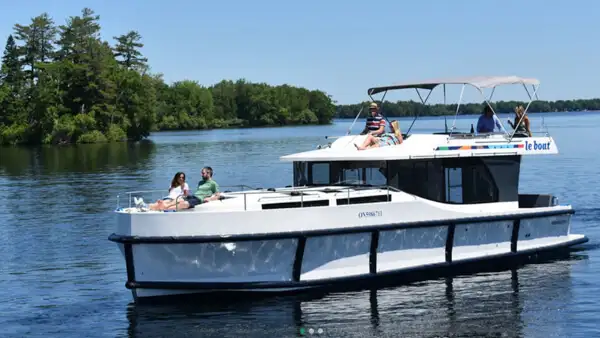
Steering forward, steering backward, and turning
The rudder blade is at the back of the stern. If you turn the steering wheel to the left, the rudder blade swings to the left and the boat moves to the left. However, first the stern swings out to the right! So you don’t steer at the front, like in a car, but at the back – when the stern swings out more to the right, the boat goes to the left.
In addition, this happens somewhat delayed, because the boat is heavy and changes its direction rather slowly. For the rudder blade to work, water has to pass by it – the faster, the better. So you always need some speed to steer – so first pick up speed, then turn the steering wheel.
If you want to change direction a lot, for example when turning, then you need some speed and enough space to complete the turn. It’s best to do this a few times on open water to get a feel for your turning circle. However, you can also manoeuvre and turn forward-backward-forward in narrower channels, similar to a car.
Practice Tip:
When reversing, you will notice that the rear end rarely runs straight, but always deviates slightly to one side. This is normal and is due to the lateral offset caused by the direction of rotation of the drive screw. When manoeuvring, you can easily correct this deviation with the bow thruster or stern thruster in order to drive straight backwards.
Driving in wind, waves and current
As a rule, houseboats are very docile and do not mind a little wave action. With strong waves from the side or from diagonally in front or behind, the boat will no longer run well straight ahead, but will always “yaw” a little to the right and left. This is normal. The easiest way to drive is against the wave or with the wave.
The houseboat is quite slow and can therefore be influenced by strong wind or waves. On the open sea against wind and wave it will drive much slower. In strong wind or waves it will also be rough on the boat, so it is best to avoid open water areas in such conditions.
On the windward (windward) side of the lake, the waves are usually smaller than on the leeward side (where the wind blows). It is usually calmer in channels than on lakes.
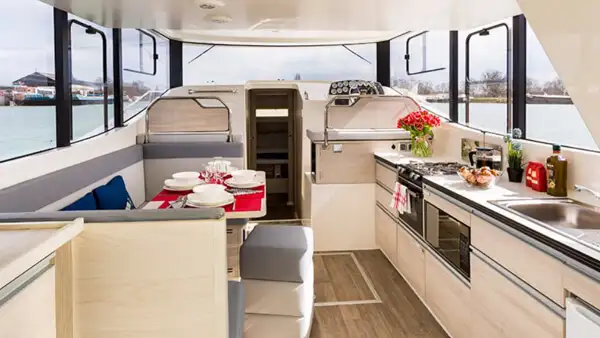
Refuelling
Refuelling is similar to refuelling a car, simply drive to the boat service station, switch off the engine and fill up with diesel. The locations of the boat refuelling stations are certainly listed in your documents.
Dinghy
With some rental companies you can rent a rowing boat, which you can tow behind the houseboat as a dinghy. This makes sense if you want to row a bit after mooring (or the children), or if you want to go fishing, otherwise the trailer can be a nuisance when mooring, casting off or manoeuvring.
Weather on the water
Keep an eye on the weather forecast. Rain is not a problem, but fog, wind and thunderstorms can be unpleasant on the water, especially on larger lakes. If there are storm warnings, stay safe in the harbour. Take the weather seriously on the water!
It’s also important to be flexible with your route so you can react to the unexpected. Plan the return journey in such a way that you can easily manage it. If everything goes well, you can always do one more loop at the end.
Cast off and mooring
When mooring, remember to hang the fenders on the side of the boat you want to moor at the right height so that you do not damage the boat (see lines and knots).
Then slowly drive parallel to the jetty, stop the boat and move it sideways with the bow thruster and stern thruster the last little bit until you arrive at the quay wall or jetty.
Attach lines fore and aft. It can also make sense to attach diagonal lines, i.e. from front to back and from back to front, so that the boat really lies still. Usually one person drives the boat and one or two other people attach the lines.
When you cast off, all the lines are released and then you can use the bow thruster and stern thruster to push the boat away from the mooring and then go forward. Then take in the fenders, do not leave them hanging outside.
Lines are neatly rolled up and fenders are neatly stowed away so that everything is ready for the next mooring or lock.
Meeting, avoiding, bridges and bottlenecks
Beware of bottlenecks – is the bridge wide enough, is it high enough, is there oncoming traffic, what is the right of way? If you are not sure, do not drive into the bottleneck. Wait in front of it and clarify the conditions, because once it gets narrow, it can become unpleasant. See traffic rules, lights and signs.
Driving through locks
In principle, a lock is also a narrow passage. There is usually one lock chamber for both directions of travel, sometimes two. At larger locks, traffic lights regulate entry and exit. At smaller locks, this is usually done by hand signals and shouts.
Wait in front of the lock until you can enter. Exiting traffic has the right of way. Then enter slowly and look out for a lockkeeper who will assign you a place.
Sometimes packages are formed in locks: The larger boats moor against the lock wall and smaller boats can then moor against the larger boats. Put out fenders on both sides and have a line at the bow (front) and a line at the stern (back).
These are best led by two people: Tie the line to the boat on one side, pass the loose end through a ring or around a bollard on the lock wall and then hold it in your hand on the boat – but do not tie it!
The water level rises or falls and the lines must then be adjusted accordingly, i.e. lengthened or shortened by hand. After opening the gates, extend slowly and carefully, paying attention to instructions. Roll up the lines and fenders and continue your journey.
Swimming from the boat
The sun is shining, it’s nice and warm and the lake is just too inviting. Why not go swimming from the boat?
But be careful: make sure you find a spot where there is no traffic, switch off the engine and check whether the boat is still or drifting. No one is allowed in the water while the propeller is still turning – that is extremely dangerous!
If the boat is still, the bathing ladder can be unfolded and everyone (except the boat driver) can go swimming. Attention:
Practical tip: Folding out the bathing ladder is often forgotten, but it is extremely important, because on many boats you can’t get back up without a ladder! One person should stay on board to be able to react in case something unexpected happens.
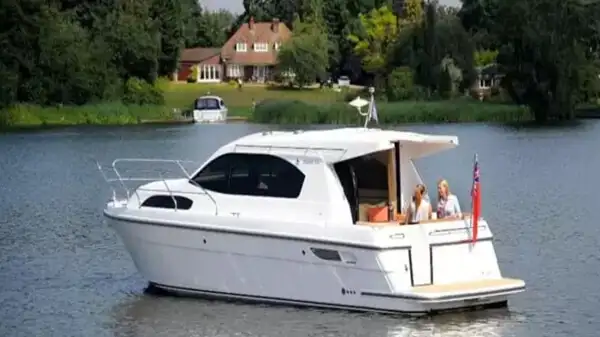
Anchoring
Anchoring is allowed in some waters, not in others, or not allowed in some places. Your boat hire company will advise you of the current regulations.
Anchoring is always allowed in case of emergency – if the engine fails on the lake (which should not happen), you can of course anchor, then calmly call your boat rental company and wait for help.
To do this, bring the boat to a complete stop, then lower the bow anchor and unwind about five times as much line or chain as the water depth.
Ideally, the anchor is marked by a buoy and you switch on the anchor light to signal to other boats that you are not underway. When recovering, pull the boat over the anchor, pull it up completely and then set off.
If the anchor doesn’t come off, you can pull it in until the chain is tight and then slowly drive forward a short distance. This will break the anchor out of the ground. Then stop, pull in the anchor and drive off.
Man overboard manoeuvre
It happens so quickly – you just want to go forward for a moment, lose your balance and end up in the water. Of course, you don’t have a life jacket on, you’re in the middle of the lake and the boat continues without you. Your fellow passengers don’t know what to do now…
To prevent this from happening, always hold the railing (handrail) with one hand when walking on the boat. The life jacket is always worn, especially on open waters.
At least one second person learns to drive the boat: Stop the engine and turn it off, then the swimmer can swim to the boat. Or turn around, slowly approach the swimmer to 2-3 metres, turn off the engine and lower the swim ladder.
A person on deck can have a line ready to throw to the swimmer. Often there is also a life ring with a line for the purpose. Then pull the person to the swim ladder and help them climb up.
Practice tip: It is best to practise the man overboard manoeuvre a few times on a lake where you have enough space in all directions. Throw a fender overboard and “rescue” it again.
Conclusion
I hope I have been able to give you a first impression of what is involved in houseboating. At first glance it may seem complicated, but don’t worry, after an initial briefing and first practical driving exercises it will all become much clearer.
It’s not really complicated and if you can drive a car, you can learn to drive a houseboat – faster than you think.
So don’t be put off, most customers of houseboat rental companies have never driven before and get on very well after a short time.
I have found a little Youtube video for you on learning to drive a houseboat – just click here.
And now I wish you lots of fun on your first houseboat holiday in Ireland!
More interesting articles for you
HOUSEBOAT HOLIDAYS IN IRELAND: 33 COMMON QUESTIONS AND ANSWERS
12 ACTIVITIES YOU CAN COMBINE WITH YOUR HOUSEBOAT HOLIDAY IN IRELAND
IRELAND IS A HOUSEBOAT PARADISE: WHERE TO GO HOUSEBOATING ON THE ISLAND
CRUISERBOAT-HOLIDAYS WITH CHILDREN ON THE SHANNON – IMPORTANT TIPS
Photo credits title image: Chris Robert on Unsplash